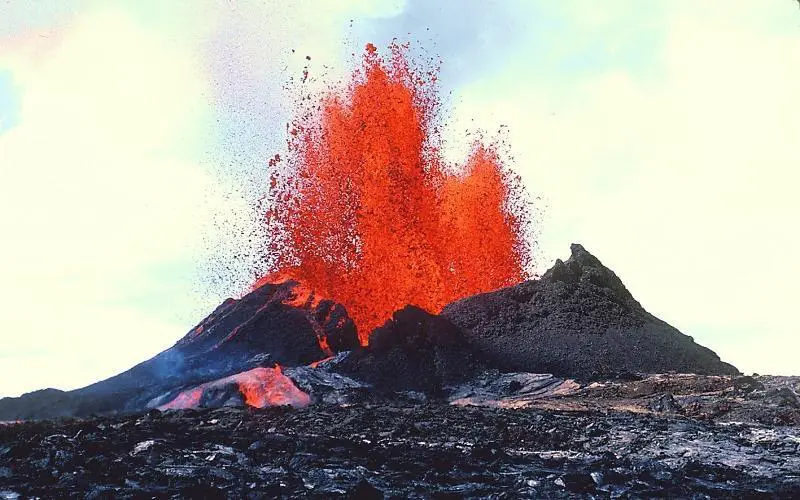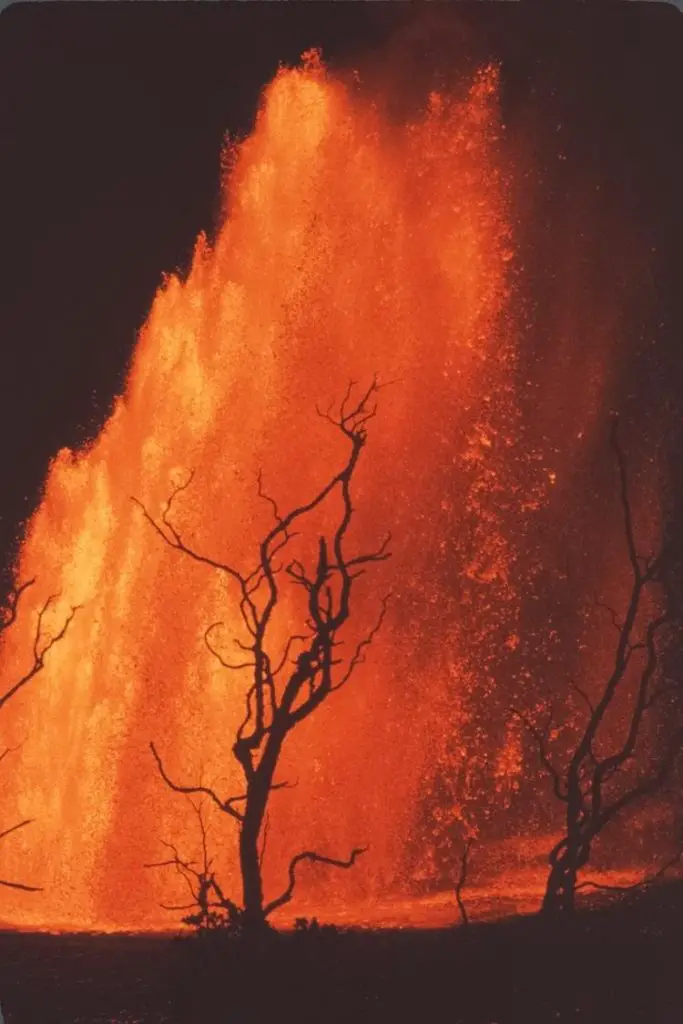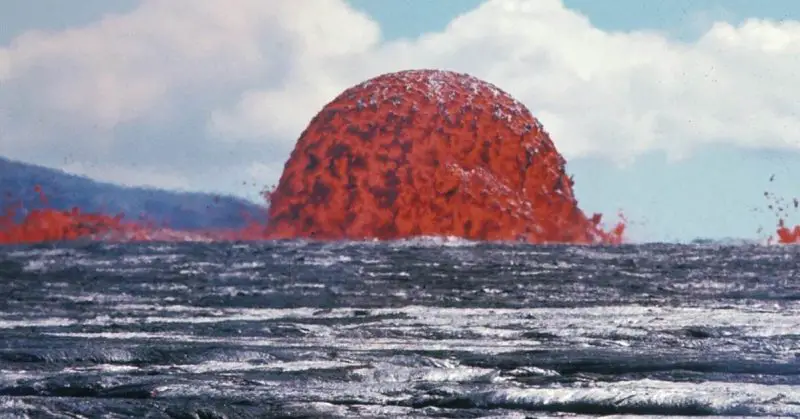At first glance, the red blob looks as if your worst childhood nightmare has come to life. At another glance, you’d think the earth is dealing with the worst possible pimple.
Well, it’s easier on the scientific mind to know that it’s a 65-foot (20 meters) symmetrical lava dome fountain captured in Hawaii in 1969 by the U.S. Geological Survey (USGS). [1] The lava that formed the dome came from the Mauna Ulu volcanic cone, a rift zone of the Kilauea volcano in Big Island, Hawaii. The Kilauea volcano is one of the most active volcanoes on earth and has been erupting since 1983, according to the Hawaii Center for Volcanology. [2]
The incredible photo was captured on October 11, 1969, by the USGS, and it was a nostalgic throwback moment for the agency when they tweeted the photo on March 29, 2018, almost 49 years later. The dramatic photo makes it looks as if the lava is coming out of the water (which is a pretty cool thought), but it was just the camera angle. The lava erupted from a large rift in the earth’s surface.
Dome fountain of episode 10, October 10–13, 1969, eruption of Kilauea Volcano. This dome fountain is about 20 m (65 ft) high. Symmetrical dome fountains such as this are rare. #Tbt #HI @Volcanoes_NPS pic.twitter.com/sKSQaVINKs
— USGS (@USGS) March 29, 2018
Mauna Ulu, “the growing mountain”
The Mauna Ulu is one of the most iconic eruptions ever to be recorded in Kilauea volcano. [3] For 5 years, from May 1969 to July 1974, the volcanic cone spurted, coughed and splurged out powerful jets of hot lava at frequent intervals. The eruption lasted 1,774 days and was the longest-lasting volcano recorded in over 2,200 years. The eruption produced an estimated 350 million cubic meters of lava. The flows could cover 44 sq. km area and some of the deposits were reported to be as far as 7.6 meters deep.
The lava dome in the photo splurged out of the eruption from October 10 to October 13, 1969.
Over time, the Mauna Ulu has been dethroned as the longest-lasting eruption in the Kilauea. Another volcanic vent on the eastern rift, Pu’u ‘Ō’ō, has been active since 1983, although, according to the USGS, “the Mauna Ulu eruption was more accessible to the public, with a viewing platform established at one point to observe a lava lake in the crater.” The Mauna Ulu remains the public favorite even though the Pu’u ‘Ō’ō has been erupting for a much longer period.
Lava is formed when the geothermal energy beneath the surface, often deeper than 100 miles, gets hot enough to melt rock. [4] Magma is the molten rock beneath the earth, while lava is magma that reaches the earth’s surface through an erupted volcanic vent.
Lava fountains can be symmetrical (very rare) or asymmetrical (more common) in the form of high-rising fluid jets. They are formed by the rapid formation and expansion of gas bubbles in the molten rock, which will eventually cause the lava to be sprayed into the air at a high velocity, forming a fountain. [5] Their sizes vary depending on the viscosity of the lava and kinetic energy of the molecules. As reported by the USGS, lava fountains range from about 30 to 330 feet (10 to 100 m) in height, although some have reached mind-blowing altitudes of 1,640 feet (500 m).
“Lava fountains erupt from isolated vents, along fissures, within active lava lakes, and from a lava tube when water gains access to the tube in a confined space,” the agency wrote.


References
- “What on Earth Is This Fiery Blob? Live Science. Laura Geggel. Retrieved April 20, 2020.
- “Kilauea.” Hawaii Center for Volcanology. Retrieved April 20, 2020.
- “1969-1974 Mauna Ulu Eruption.” USGS. Retrieved April 20, 2020.
- “Magma.” National Geographic. Retrieved April 20, 2020.
- “Lava fountain.” USGS. Retrieved April 20, 2020.
- “A Look Back at Kilauea’s Spectacular 1969 to 1974 Mauna Ulu Eruption.” The Atlantic. Alan Taylor. Retrieved April 20, 2020.
- ” The First Two Decades of the Pu‘u ‘Ö‘ö-Küpaianaha Eruption: Chronology and Selected Bibliography. USGS. Heliker and Matox. Retrieved April 20, 2020.

